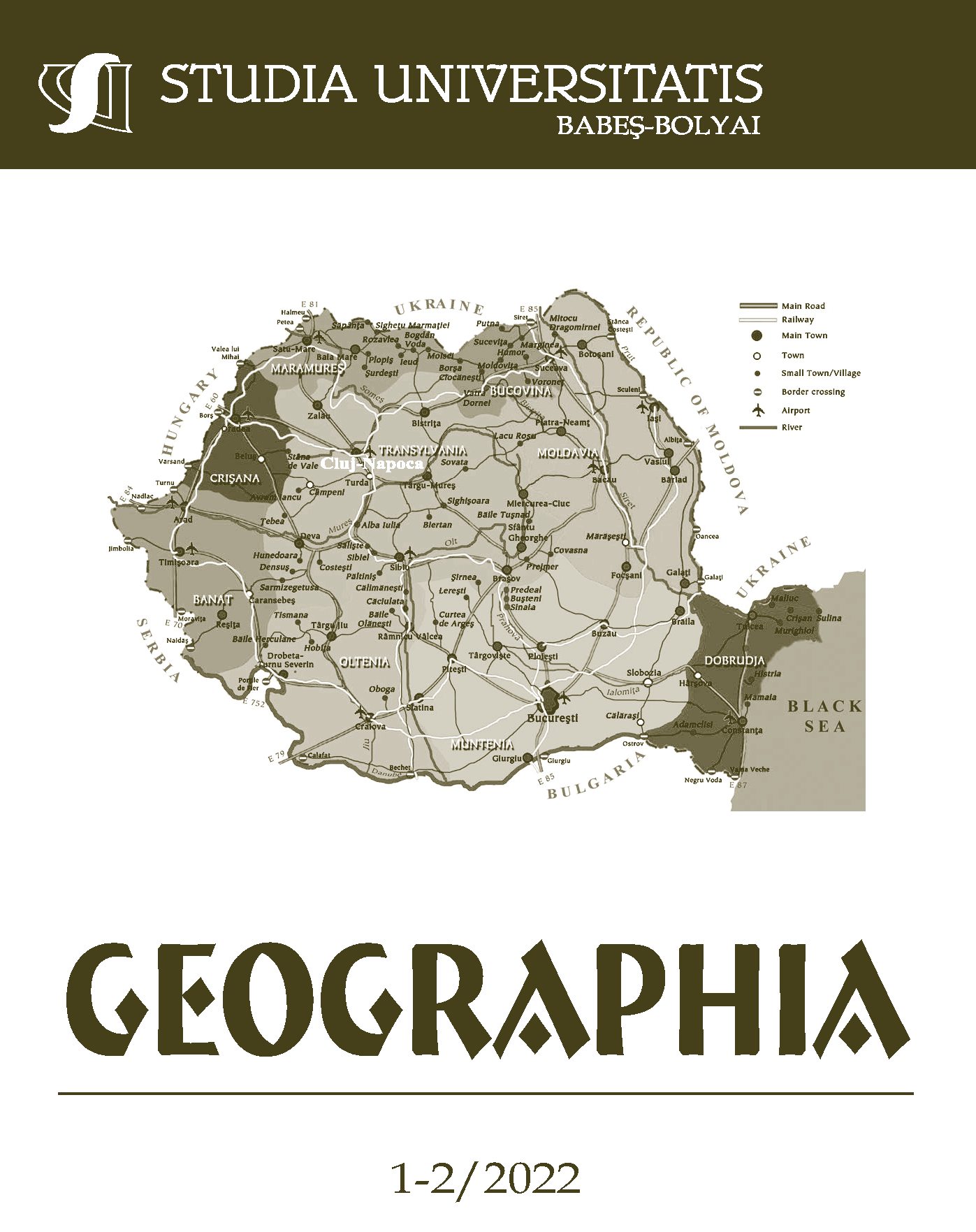THE EVOLUTION OF CLUJ FORTRESS FROM EXTRAMUROS AREA AND THE IMPRINT OF THE GEOSITE IN THE GEOGRAPHICAL LANDSCAPE OF CLUJ-NAPOCA CITY
DOI:
https://doi.org/10.24193/subbgeogr.2022.02Keywords:
evolution, Fortress, extramuros / intramuros, sandstones and conglomerates, geosite, geographical landscape, Cluj-Napoca, Romania.Abstract
Cluj Fortress was built by the military garrison of the Habsburg Empire to have a defensive role in tragic periods. The site of its location was chosen possibly due to morphology, the presence of landforms developed on sandstones and conglomerates which led provided conditions for living and development in that place. The evolution of the area from extramuros to intramuros was shaped by the living necessities that the military garrison had to satisfy. By entering the area beyond the walls, “the world down there”, they had access to the means of satisfying their needs, to the necessary substance and energy exchange. The emergence of miserable households, mere holes in the slope, was possible due to the geological structure. They had a negative impact on the geographical landscape, due to the negative look of the slope, but also because of the precarious living conditions of the inhabitants of that area. The development of communities including disfavoured people determined miserable living conditions, while they tried to survive in different manners. By means of the used methodology, the paper highlights the evolution of Cluj Fortress since ancient times until today, and to emphasize the importance of the Fortress site from a scientific and anthropogenic point of view, by means of the geomorphosite inventory list.References
Buzilă, L., Drăguț, L., Drăguleanu, C., Baciu, C. (2002), Geomorfologia și riscul geomorphologic, in: Cristea, V., Baciu, V., Gafta, D., (eds.), Municipiul Cluj – Napoca și zona periurbană, Studii ambientale, Editura Accent, Cluj Napoca, p. 15-24.
Carrion-Mero, P., Ayala-Granda, Alicia, Serrano-Ayala, S., Morante-Caraballo, F., Aguilar-Aguilar, Maribel, Gurumendi-Noriega, M., Paz-Salas, Nataly, Herrera-Franco, Gricelda, Berrezueta, E. (2020), Assessment of Geomorphosites for Geotourism in the Northern Part of the “Ruta Escondida” (Quito, Ecuador), Sustainability, 12 (20), 8468.
Castree, N., (2019), Earth system science. In The International Encyclopedia of Geography, John Wiley & Sons, Hoboken.
Cendrero, A. (1996), El patrimonio geológico. Ideas para su protección, conservación y utilización, in: El patrimonio geológico. Bases para su valoración, protección, conservación y utilización. Serie Monografías del Ministerio de Obras Públicas, Transportes y Medio Ambiente, Ministerio de Obras Públicas, Transportes y Medio Ambiente, Madrid, pp 17–27.
Danci, I., Irimuş, I.A, Vieru, Ioana, Toma, Bianca (2010), Valorificarea turistică a geomorfositurilor în aria metropolitană clujeană, International Conference The Role of Tourism in Territorial Development, Vol. III, p. 81-87, Presa Universitară Clujeană.
Deac, Simona, Irimuş, I.A, Păcurar, B.N. (2013), The landscape morphology of Cluj-Napoca Residential Neighbourhoods, Studia UBB Geographia, vol. 58 (LVIII), 2, p. 99-111.
Deac, Simona-Octavia, Păcurar B.N., Irimuș I.A, Trif Teodora (2014), The Aesthetic and Ecological Values of Cluj-Napoca Urban Landscape, Studia UBB Geographia, 59 (LIX), 1, p. 155-164.
Di Paola, Giorgia Maria Francesca (2018), Central Place and Liminal Landscape in the Territory of Populonia, Land, 7 (3), 94.
Guenzel, S. (2013), Topologie, Transcript Verlag Publisher, Bielefeld.
Harta Geologică 1:200.000, IGR, Bucharest.
Hyun Sil Shin, Yaohua Chen, Won Ho Lee, Dong Hyun Kim (2015), Sustainability of Historical Landscape to Gwanghalluwon Garden in Namwon City, Korea, Sustainability, 7, 8565-8586.
Irimuș, I.A. (1994), Aspecte metodologice privind studiul reliefului României, Târgu Mureș.
Irimuș, I.A., (1997), Modele de organizare a spațiului geografic în perimetrul județului Cluj, Referate și Comunicări de Geografie, vol. IV, p. 97-102, Deva.
Irimuş I.A. (2004), Relieful și riscurile geomorfologice, in: Cocean, P. (ed.) Planul de Amenajare a teritoriului Regiunii de Nord-Vest (PATR). Coordonate majore, I, p. 12-23, Presa Universitară Clujeană, ISBN 973-610-284-X.
Irimuş, I.A. (2006), Vulnerabilitate şi riscuri asociate proceselor geomorfologice în planningul teritorial, Riscuri și Catastrofe, V, no. 3 / 2006, p. 21-33, Casa Cărţii de Ştiinţă, Cluj-Napoca.
Irimuş, I. A., Mureşan, Alina (1994), Rolul diagnozei şi prognozei în studiul mediului geografic, Studia UBB Geographia, 39, 1 / 1994, p. 13-23.
Irimuş, I.A., Petrea, D., Rus, I., Corpade, Ana-Maria (2010), Vulnerability of Cluj Urban Area to Contemporary Geomorphologic Processes, Studia UBB Geographia, 55 (LV), 1, p.19-33, Cluj University Press, Cluj-Napoca.
Mac, I., Hosu, Maria (2003), Autoproiectarea reliefului în sistemele geomorfologice cu diferite grade de sensitivitate, Analele Universității Spiru Haret, Seria Geografie, no. 6, pp. 5-15.
Meszaros, N., Clichici, O. (1976), Pe poteci cu bănuței de piatra, Edit. Sport-Turism, București.
Pereira, P. (2007), Património geomorfológico: conceptualizaçăo, avaliaçăo e divulgaçăo. Aplicaçăo ao Parque Natural de Montesinho, PhD thesis, Departmento de Cięncias da Terra, Universidade do Minho.
Pereira, P., Pereira, D.I. (2010), Methodological guidelines for geomorphosite assessment, Géomorphologie. Relief, Processus, Environnement, 16 (2), pp. 215–222.
Pralong, J.P., Reynard, E. (2005), A proposal for the classification of geomorphological sites depending on their tourist value, Il Quaternario. Italian Journal of Quaternary Sciences, 18 (1), pp. 315–321.
Quesada-Román, A., Torres-Bernhard, L., Ruiz-Álvarez, M.A., Rodríguez-Maradiaga, M., Velázquez-Espinoza, G., Espinosa-Vega, C., Toral, J., Rodríguez-Bolaños, H. (2022), Geodiversity, Geoconservation, and Geotourism in Central America, Land, 11, 48.
Reynard, E., (2008), Scientific research and tourist promotion of geomorphological heritage, Geogr. Fis. Dinam. Quat., 31, pp. 225–230.
Szádeczky Kardoss, Gy. (1918), Pusztító kőomlas a kolozsvári Fellegváron, Term.-tud. Közlöny, L., Budapest, p. 167-173.
Szilárd-Lehel, P. (2011), Studiu de geomorfologie aplicată în zona periurbană Cluj-Napoca, PhD thesis, “Babeș-Bolyai” University of Cluj-Napoca.
Xántus, J. (1942), Földomlás a Fellegváron, Erdély, XXXIX/5(347.), Kolozsvár, p. 70-75.
https://actualdecluj.ro/foto-cetatuia-de-acum-100-de-ani-era-locuita-de-banditi-prostituate-si-oameni-ai-pesterilor/. Last accessed on 10 February 2022.
https://www.omnia.ie/index.php?navigation_function=3&europeana_query=Dealul%20Cet%C4%83%C8%9Buia. Last accessed on 10 February 2022.
https://www.stiridecluj.ro/social/cetatuia-cluj-din-1890-pana-in-1965-de-la-oamenii-grotelor-la-demolari-si-civilizatie-video. Last accessed on 10 February 2022.
Downloads
Published
How to Cite
Issue
Section
License
Copyright (c) 2022 Studia Universitatis Babeș-Bolyai Geographia

This work is licensed under a Creative Commons Attribution-NonCommercial-NoDerivatives 4.0 International License.





 ©Studia Universitatis Babeş-Bolyai Geographia. Published by Babeș-Bolyai University.
©Studia Universitatis Babeş-Bolyai Geographia. Published by Babeș-Bolyai University.